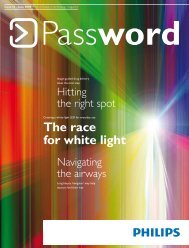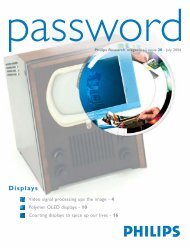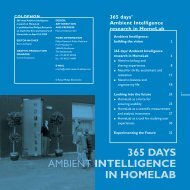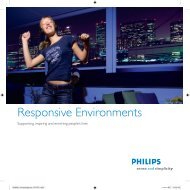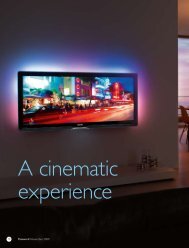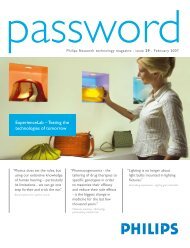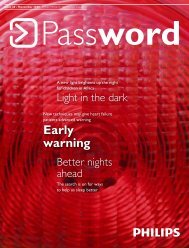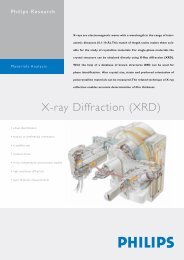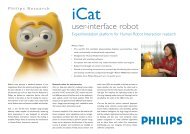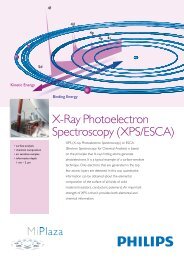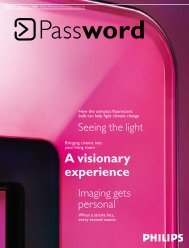article - Philips Research
article - Philips Research
article - Philips Research
Create successful ePaper yourself
Turn your PDF publications into a flip-book with our unique Google optimized e-Paper software.
WACS700 music center<br />
Main <strong>article</strong> media centers Main <strong>article</strong> media centers<br />
“The harsh market reality is that in the world of the 21st century digital consumer, the content<br />
is king,” says Erik Kaashoek, responsible at <strong>Philips</strong> Consumer Electronics (CE) for<br />
migrating <strong>Philips</strong> <strong>Research</strong> projects into viable commercial products for CE. “Therefore any<br />
future consumer media center product – if it is to enjoy universal success – needs to put the<br />
needs of the consumer and their desire to intuitively access and organize this digital content<br />
fi rst, and allow the implementation to follow second. Mass-market consumers simply<br />
won’t buy into tomorrow’s media centers if they don’t continue to make their lives<br />
dramatically easier and can accommodate every form of digital media and content<br />
without introducing complexity.”<br />
Together we can achieve more<br />
“The problem is that the engineering and fi nancial resources required to sustain media center<br />
innovation at its current rate is growing exponentially,” notes Frank van Tuijl, R&D project<br />
leader for media centers with <strong>Philips</strong> <strong>Research</strong>.<br />
In fact, it is a massive challenge, even for companies the size of <strong>Philips</strong>, and not without a<br />
huge element of risk. Yet it doesn’t have to be this way. By working together, CE companies<br />
could distribute the technological development and fi nancial burden and achieve far more<br />
for the consumer.<br />
“Recent evolutions of many traditional PC and consumer electronics products are beginning<br />
to encroach on each other’s territories,” illustrates van Tuijl. “Both the games console and PC<br />
products offer video and music playback, and hard drive set-top boxes provide secure on-line<br />
MCP9350i media center<br />
shopping, pay-per-view video and TV programming. And there are even hard drive-based<br />
audiovisual products that include PC operating systems with digital hub-like multi-room<br />
interface capabilities.”<br />
“However, all these products have evolved along separate paths to deliver certain specifi c<br />
functionality supremely well, and have then been adapted – almost as an afterthought,” explains<br />
van Tuijl. “This inevitably compromises the product for attempting to do more than was<br />
originally intended by conventional re-use or re-cycling of established software and standards.”<br />
“That’s not to say there’s anything wrong with software re-cycling and sharing – it’s<br />
commercially vital and actually what the Open Media Center aims to conserve and promote.<br />
But it’s at the multiple – rather than single – PC/CE vendor scale that we’ll see the whole<br />
market migrating in a new direction and developing new software better suited to the universal<br />
media center ideal.”<br />
Indeed, that the current products have successfully evolved from previous products is<br />
testament to the pragmatism and design skill of the PC and CE manufacturers. But it also<br />
suggests that no one is willing to risk developing a bespoke universal media center solution<br />
alone – it’s just too expensive.<br />
“It would demand tens to hundreds of millions of Euros in R&D investment – particularly on<br />
the software side,” says van Tuijl. “And individual companies would have to master unfamiliar<br />
technology if they hoped to create a media center that was truly all things to all users.<br />
Even a company the size of <strong>Philips</strong> cannot be an expert in all the required disciplines.”<br />
Towards an Open Media Center approach<br />
Frank van Tuijl’s research team has already spent several years of exhaustive investigation<br />
within <strong>Philips</strong> <strong>Research</strong> into media centers. “We realize we will fi nd it very challenging to<br />
develop universal next-generation media centers on our own,” van Tuijl says. “Yet media<br />
centers are an enormous part of the future of consumer electronics that simply cannot be<br />
ignored. Industry collaboration is the only viable way forward to migrate existing product<br />
offerings into a harmonized, universal solution.”<br />
This is how the <strong>Philips</strong> ‘Open Media Center’ idea was born. “It’s a concept centered around a<br />
strategic, industry-wide collaboration involving an open source type of approach that we want<br />
to openly propose to the world’s consumer electronics companies,” explains Erik Kaashoek.<br />
“It’s a completely new paradigm. One built from the ground up to meet the needs of the end<br />
application and that – who knows – could one day be extended to encompass a thriving open<br />
source community as well?”<br />
But it’s early days yet for the Open Media Center. “It’s a vision with no predetermined<br />
architecture or technology road maps,” says Kaashoek, “but a vision that we believe is of<br />
paramount importance to the CE sector. It will encourage the strategic migration of the best<br />
features of each area of the industry into a new common, unifi ed framework for the future.”<br />
The operating system for an Open Media Center (OMC) product would also likely be based on<br />
a non-proprietary OS such as Linux, with the joint development middleware in the center, and<br />
major proprietary application plug-ins on top that could possibly be extended to include opensource<br />
products as well (perhaps like shareware and freeware software in the PC world sits<br />
The ‘mythical’<br />
set-top box<br />
At the recent Consumer Electronics<br />
Show (CES) in Las Vegas, <strong>Philips</strong><br />
demonstrated a tablet TV front-end<br />
wirelessly streaming SDTV<br />
(Standard-Defi nition TV) digital video<br />
from a so-called ‘MythTV‘ hub using the<br />
latest state-of-the-art, low-power <strong>Philips</strong><br />
Semiconductor technology. A second TV<br />
front-end has also been developed that<br />
receives HDTV (High-Defi nition TV)<br />
streams from the same hub over<br />
Ethernet and displays them on a HDTV.<br />
Nexperia is the <strong>Philips</strong> brand for a unique<br />
group of products that streamline<br />
development of next-generation,<br />
connected multimedia appliances.<br />
MythTV is a General Public License<br />
(GPL) based, but proprietary ’plug-in‘<br />
software product that allows developers<br />
to create an experimental ’home media<br />
convergence box‘ using open-source<br />
software and operating systems.<br />
“MythTV’s capabilities include pause,<br />
fast-forward and rewind of live TV;<br />
installation of multiple video capture<br />
cards to record more than one program<br />
at a time to different hard disks, and<br />
support of multiple front-end clients<br />
each with a common view of all<br />
available programs,” explains Eric<br />
Persoon of <strong>Philips</strong> Advanced<br />
Semiconductors Laboratories. “The<br />
software also includes other useful<br />
functionality such as a picture-viewing<br />
application, a DVD viewer and a music<br />
playing application that supports MP3.”<br />
The CES application was based on the<br />
Nexperia STB810 semiconductor system<br />
solution. This combines the <strong>Philips</strong><br />
PNX8550 home entertainment engine, a<br />
Linux operating system and all required<br />
AV codecs. The result is a unit that<br />
can provide video telephony, time-shift<br />
recording, DVD playback, personal video<br />
recording, network connectivity and<br />
Voice-over-IP.<br />
8 <strong>Philips</strong> <strong>Research</strong> Password 26 l February 2006 <strong>Philips</strong> <strong>Research</strong> Password 26 9<br />
l February 2006




